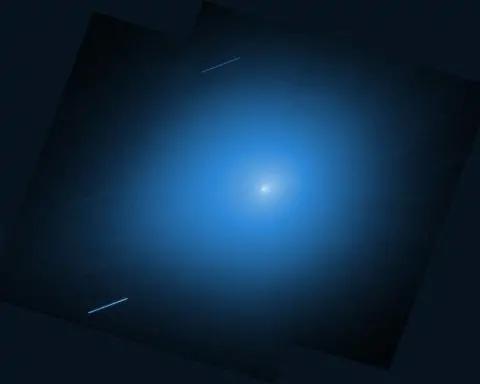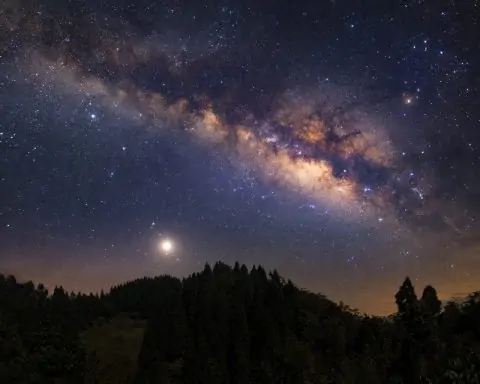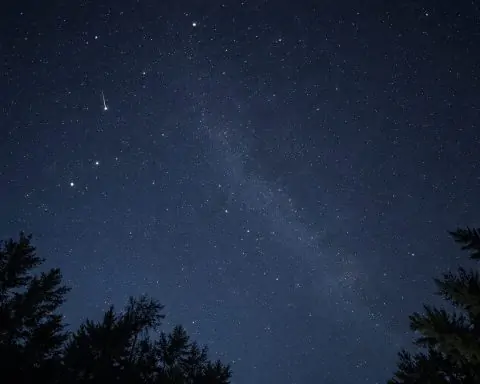- Geomagnetic Storm: A recent solar coronal hole drove a strong G3 geomagnetic storm on Oct. 1–2, spreading auroras into mid-latitudes [1]. By Oct. 3 the storm should ease to only minor (G1) levels [2] [3]. Watch the northern sky late on Oct. 2–3 for the last aurora displays; by Oct. 4 conditions will calm as solar wind subsides [4] [5]. NOAA warns of G2–G1 storming Oct. 2–3 (down from G3 on Oct.2) [6].
- Bright Satellites: NASA’s Spot the Station alerts remind skywatchers that the International Space Station (ISS) is bright at dawn/dusk [7]. New Starlink satellite trains are likely – SpaceX is launching batches on Oct. 2 (Vandenberg) and Oct. 5 (Florida) [8]. After these flights, look for linear “trains” of fast-moving dots crossing the early-night sky (as seen recently) [9] [10].
- Planet Sightings: In the west after sunset, Saturn is high and brilliant (+0.9 mag) in Aquarius (post-opposition) [11]. On Oct. 4–5 the bright waxing gibbous Moon slides past Saturn in the southeast [12] (the star Fomalhaut is nearby). Mercury and dim Mars hug the southwestern horizon at dusk, with Mercury’s best evening elongation coming later this month [13]. In the early morning sky, two “bright star”-like planets dominate: Venus (lower right) and Jupiter (above) [14].
- Moon Events: The Moon is a waxing gibbous, about 85–90% lit on Oct. 3–4 and heading toward the Oct. 6 Full “Harvest” Supermoon [15]. Notably, Oct. 4, 2025 is International Observe the Moon Night [16] – a worldwide event encouraging moonwatching. (No eclipses this weekend, but enjoy the bright, almost-full Moon as it rises after sunset.)
- Meteor Activity: No major meteor shower peaks exactly on Oct. 3–4. The Draconids will peak around Oct. 8–9 (though moonlight will dim them) [17] [18], and the Orionids peak mid-month. On Oct. 3–4 you’ll see mostly sporadic meteors or Taurid/Agenid debris. NASA’s all-sky camera network recorded 24 fireballs on Oct. 1 alone [19]. Keep an eye out for random bright meteors, especially from late dusk into early dawn.
- New Comets: Two recently found comets brighten in October. C/2025 A6 (Lemmon) is approaching perihelion Oct. 21. It may reach ~mag 4 (barely naked-eye) by late Oct [20]. Lemmon will be low in the eastern sky before dawn (near the Big Dipper) [21]. As British comet expert Nick James enthuses, “This comet is developing very nicely and it is already an impressive object, well-placed for observation in the morning sky… It is definitely worth getting up for!” [22]. The other newcomer, C/2025 R2 (SWAN), will pass near the star Spica in mid-Oct. Forecasters estimate it will peak around magnitude 6–7 [23] – on the cusp of naked-eye visibility. With very dark skies and patience you might glimpse SWAN as a small greenish fuzz. (Good binoculars will help! [24])
- Sky Conditions: The bright gibbous Moon will wash out faint stars on Oct. 3–4, so plan observations accordingly (maybe hide the Moon behind a barn!). The Zodiacal Light – a faint “false dawn” glow – can still be seen in the eastern sky before full dawn through early October [25]. Check local forecasts and plan where to watch the ISS and auroras. For up-to-the-minute predictions, see NOAA’s SWPC space-weather updates and NASA’s Spot the Station alerts [26] [27].
<div markdown=”1″><!– Begin Satellite Passes Paragraph –> :contentReference[oaicite:27]{index=27}Satellites streak across the sky at dawn/dusk. SpaceX’s Starlink trains are often visible shortly after launch: bright, evenly-spaced lights that move together like a miniature “train”:contentReference[oaicite:28]{index=28}. (Recent launches mean new trains on the nights following Oct. 2–3:contentReference[oaicite:29]{index=29}.) Meanwhile, the ISS is visible as a bright, fast-moving “star” about 90 minutes apart whenever it crosses your sky. NASA notes that all ISS sightings occur within a few hours of sunrise or sunset:contentReference[oaicite:30]{index=30}. Sign up for NASA’s Spot the Station to get precise pass times for your location. </div> <div markdown=”1″><!– Begin Comets Paragraph –> :contentReference[oaicite:31]{index=31}Comet SWAN (green) near the star Spica (bright). Two new comets will be gracing the sky in October. C/2025 R2 (SWAN) was just discovered in SWAN/SOHO images, and amateur trackers report it near 7th magnitude. Models forecast it will peak around mag +6 to +7 in mid-October:contentReference[oaicite:32]{index=32}, flirting with naked-eye visibility. It should appear near Spica in Libra in mid-Oct. C/2025 A6 (Lemmon), found this year, is brightening fast. By late October it may reach mag +4 (barely naked-eye):contentReference[oaicite:33]{index=33}. Lemmon climbs high in the pre-dawn sky, low in the east near the Big Dipper:contentReference[oaicite:34]{index=34}. British astrophotographer Nick James encourages watchers: “This comet is developing very nicely… well-placed for observation in the morning sky… It is definitely worth getting up for!”:contentReference[oaicite:35]{index=35}. Binoculars or a small telescope will reveal each comet’s greenish coma and faint tail to those who seek them. </div>
Sources: Authoritative skywatch forecasts and news by NASA, NOAA/SWPC, SpaceWeather, EarthSky, Space.com and others [28] [29] [30] [31] [32] [33] [34] [35] [36] [37]. These institutions provide up-to-date guidance on solar storms, aurora predictions, planet visibility, and transient objects visible in our skies.
References
1. www.spaceweather.gov, 2. www.space.com, 3. www.spaceweather.gov, 4. www.space.com, 5. www.spaceweather.gov, 6. www.spaceweather.gov, 7. www.nasa.gov, 8. spaceflightnow.com, 9. www.space.com, 10. spaceflightnow.com, 11. earthsky.org, 12. earthsky.org, 13. earthsky.org, 14. earthsky.org, 15. earthsky.org, 16. science.nasa.gov, 17. earthsky.org, 18. earthsky.org, 19. spaceweather.com, 20. www.livescience.com, 21. www.fox8live.com, 22. www.livescience.com, 23. www.space.com, 24. www.space.com, 25. earthsky.org, 26. www.spaceweather.gov, 27. www.nasa.gov, 28. www.spaceweather.gov, 29. www.space.com, 30. www.nasa.gov, 31. earthsky.org, 32. earthsky.org, 33. earthsky.org, 34. spaceweather.com, 35. www.livescience.com, 36. www.space.com, 37. spaceflightnow.com










